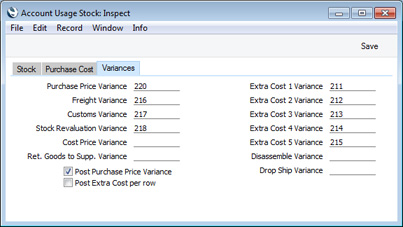Account Usage Stock - Variances Card
This page describes the fields on the 'Variances' card of the Account Usage Stock setting. Please follow the links below for descriptions of the other cards:
---

Please refer to the
'Price Variances' page for details about most of the Accounts on the 'Variances' card and about the
Post Purchase Price Variance option.
It is recommended that you specify Variance Accounts even if you are not using the Price Variances feature. If you enter a Goods Receipt with Freight and/or Customs charges in the footer and/or Extra Costs on the 'Extra Costs' card and these extra costs cannot be distributed to the various Item rows without an amount being left over, that left-over amount will be posted to the appropriate Variance Account when you mark the Goods Receipt as OK and save it.
If you want to give a name to each of the Extra Cost Variance Accounts, use the User Defined Field Labels - Extra Costs setting in the Stock module.
- Stock Revaluation Variance
- Paste Special
Account register, Nominal Ledger/System module
- If you specify a Stock Revaluation Variance Account here, it will be offered as the default Variance Account in each new Stock Revaluation record.
- In the Nominal Ledger Transaction that results from a Stock Revaluation, any increase in the value of the Items in the Stock Revaluation will be debited to the relevant Stock Account and credited to the Variance Account. Any decrease in the value of the Items will be credited to the relevant Stock Account and debited to the Variance Account.
- Please refer here for full details about Stock Revaluations.
- Cost Price Variance
- Paste Special
Account register, Nominal Ledger/System module
- You should specify a Cost Price Variance Account if you are using the Post Cost Price Variance (When using Cost Model "Cost Price") option in the Cost Accounting setting. Please refer to the description of this option here for details.
- Ret. Goods to Supp. Variance
- Paste Special
Account register, Nominal Ledger/System module
- When you return an Item to a Supplier, the calculation of the cost value of that Item should ideally satisfy two requirements:
- The cost should be the same as the original purchase cost. This will be the value of any Credit Note that the Supplier sends you, and is the value that will allow the Purchase Accruals Account to balance,
- Returning an Item to its Supplier is one way of removing that Item from stock. The value of all removals from stock should be calculated using the usual Cost Model.
These two requirements can result in two different valuations for the Item being returned. The difference between the two valuations is a variance. That variance will be posted to the Account that you specify here. - Post Extra Cost per row
- If a Goods Receipt contains more than one row and you have entered an extra cost on flip H, the resulting Nominal Ledger Transaction will usually contain a single posting to the relevant extra cost Accrual Account for the total value of the extra cost. For example, a Goods Receipt with four rows with Freight and Customs charges will generate a single posting to the Freight Accrual Account and a single posting to the Customs Accrual Account. No Objects will be assigned to these postings.
- However, if you select this option, separate postings for each Object will be made to the relevant extra cost Accrual Account.
- Disassemble Variance
- Paste Special
Account register, Nominal Ledger/System module
- When you disassemble an Item that you have constructed using a Production record, the assembled Item will be removed from stock, and the components will be returned to stock.
- There may be a difference in the value of the assembled Item in the original Production and in the disassembling Production. The value of the assembled Item in the disassembling Production will be calculated using the usual Cost Model. If there is a difference, it will be debited (if the value has increased) or credited (if it has decreased) to the Disassemble Variance Account that you specify here.
---
Settings in the Stock module:
Go back to:
